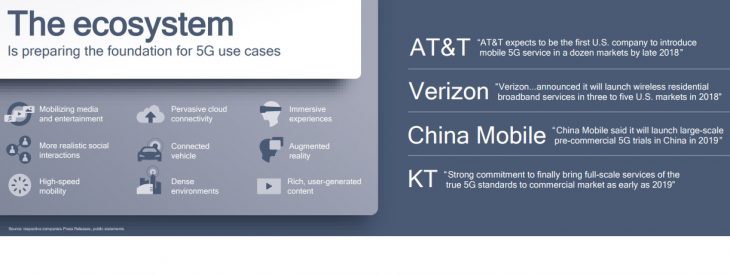
LAS VEGAS – The buzz around 5G can be seen almost everywhere as you walk on the show floor of the 2018 Consumer Electronics Show, where it becomes clear that its impact will reach far beyond just enabling super-fast smartphones.
The transition to 5G will also power emerging technologies such as virtual reality, self-driving cars and other Internet of Things (IoT) gadgets. The speeds offered by the next generation of wireless technology will be essential in order to make virtual reality truly wireless, while its low latency will be crucial for autonomous vehicles. The current VR and AR games now out can be compelling, but what if car passengers could stream content while on the move?
However, one of the most obvious applications of 5G is as a replacement for traditional home internet service. "This technology is going to offer new types of services that were not possible before, but also reduces the cost," said Matt Grob, executive vice president of technology for Qualcomm Technologies during a panel discussion on 5G at CES.
Testing of 5G is still underway but when launched it could allow users to download an entire 4K movie in under four seconds, for example.
Grob said Qualcomm expects commercial launches of 5G to begin in 2019. AT&T has said it will launch mobile 5G in a dozen U.S. markets late this year as it races against Verizon Wireless to deliver 5G services first to U.S. customers. Canadian carriers are well into the testing phases and will likely roll out 5G soon thereafter.
While cable companies and telcos continue to install fiber-optic cable to reach gigabit speeds, 5G has the potential of being even faster than a wired connection. Without the need to dig up streets or physically lay down cable, this could open the market to new 5G mobile network providers, despite its short distance limitations.
The emergence of 5G will provide many challenges to network operators, perhaps the greatest is the convergence of wired and wireless networks, opening up new business models writes Ben Cardwell, senior vice president of fibre optics and network technology manufacturer CommScope Mobility Solutions today in his blog.
“Many of our customers are reorganizing around this concept, breaking down silos within their company as formerly separate businesses come together,” he writes.
Many operators, he says, are focused on driving fibre deeper into their networks to enable centralized or Cloud RAN architectures and large-scale small-cell deployments that bring the fiber closer to subscribers. “Companies with existing fibre networks are monetizing them by selling access for small cell backhaul. Some are even building their own small cell networks and leasing them out to wireless operators.”
This development is spurring some unusual partnerships between cable companies, wireless providers and neutral hosts he adds.
An additional challenge will be the convergence of licensed and unlicensed spectrum as new frequencies such as 3.5 GHz open up as one of the global 5G bands. “The Citizen Broadband Radio Service in the U.S. will support both licensed and unlicensed users and enable new use cases such as private and wholesale LTE networks,” says Cardwell.
“5G will likely start as a capacity enhancement for areas with high concentrations of users and as a driver, opening up new uses cases in vertical markets.” – Ben Cardwell, CommScope
There are also numerous new business opportunities linked to the 3.5 GHz frequency. “A manufacturer could deploy a private LTE network in this band to wirelessly control robotics in a factory. Or a neutral host could deploy an LTE network in a stadium or shopping mall and sell capacity to service providers,” he adds.
Despite the changes, he’s confident that LTE will remain a constant for years to come as the foundation for the network-of-networks that 5G promises. “Someday, 5G will become the primary macro network technology, but 5G will likely start as a capacity enhancement for areas with high concentrations of users and as a driver, opening up new uses cases in vertical markets,” he explains.
In the future architectural changes in 5G will enable operators to select fronthaul options that optimize for best latency or throughput performance. “Ultimately, 5G will enable very low latency applications for the Internet of Things such as industrial manufacturing with robotic manufacturing coordinated wirelessly,” he adds.
Near-term challenges
Among the near-term challenges, he notes, is that small cells are still too hard to deploy. Site acquisition is also a huge challenge. “We’re starting to see larger volume projects, but it still takes longer than anyone wants,” says Cardwell.
He is also concerned that 5G’s use in millimeter wave bands creates rampant signal distortion in the higher frequencies. “Fixed wireless access deployments in mm-wave bands will be well suited to massive MIMO and active antennas,” he says, adding operators who want to add new spectrum or technologies will likely need antenna replacements that support existing frequency bands as well as the new ones.
“Despite the challenges, this year will see significant progress in defining 5G both as a standard and for real-world implementations. It isn’t here yet, but it’s going to be fun figuring out how to make 5G happen.”
Cartt.ca consumer electronics editor John Bugailiskis is in Las Vegas this week covering the Consumer Electronics Show.



